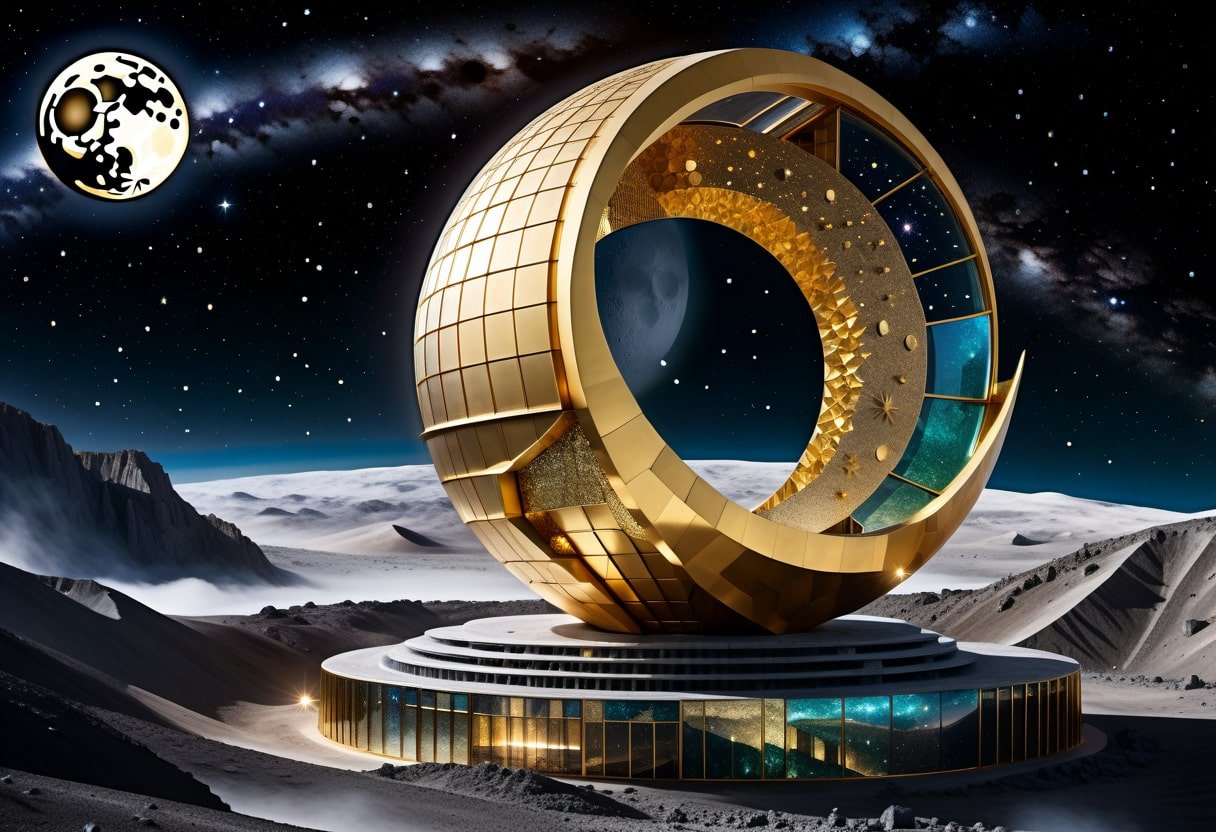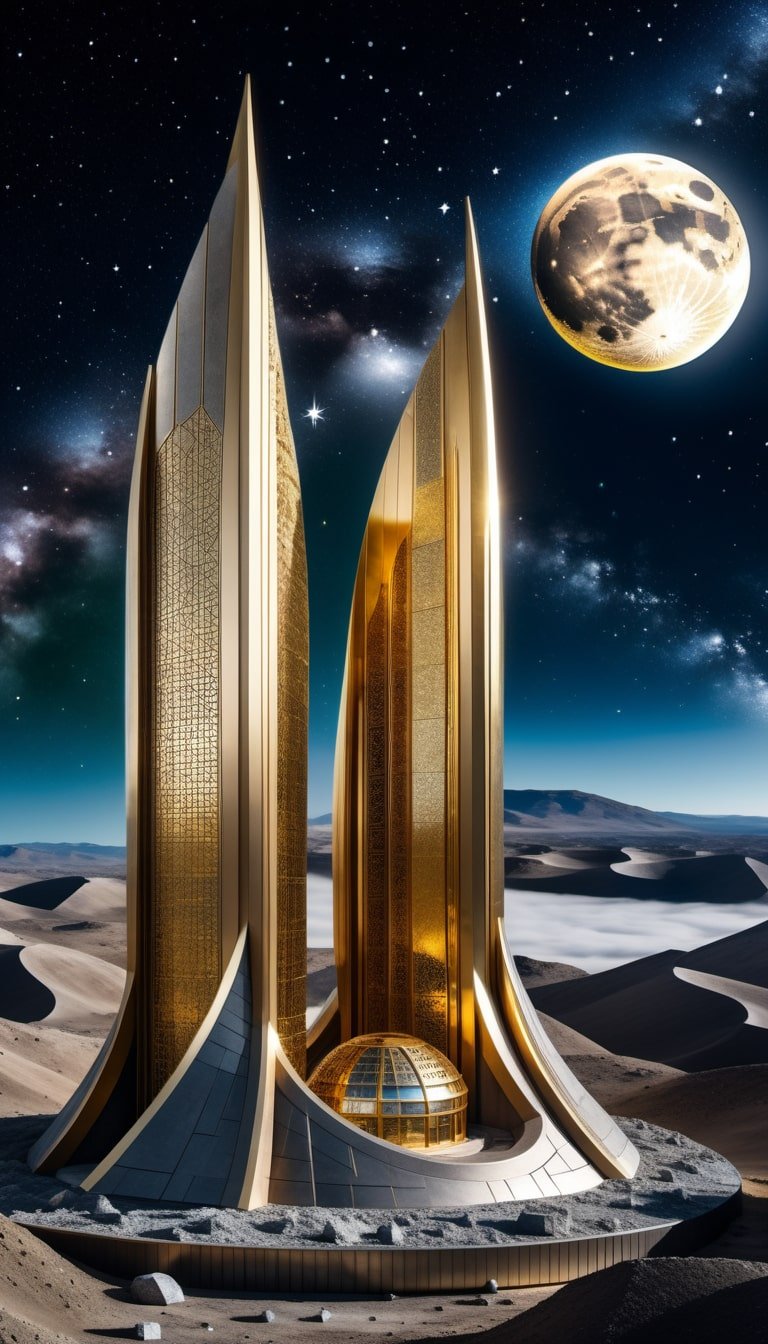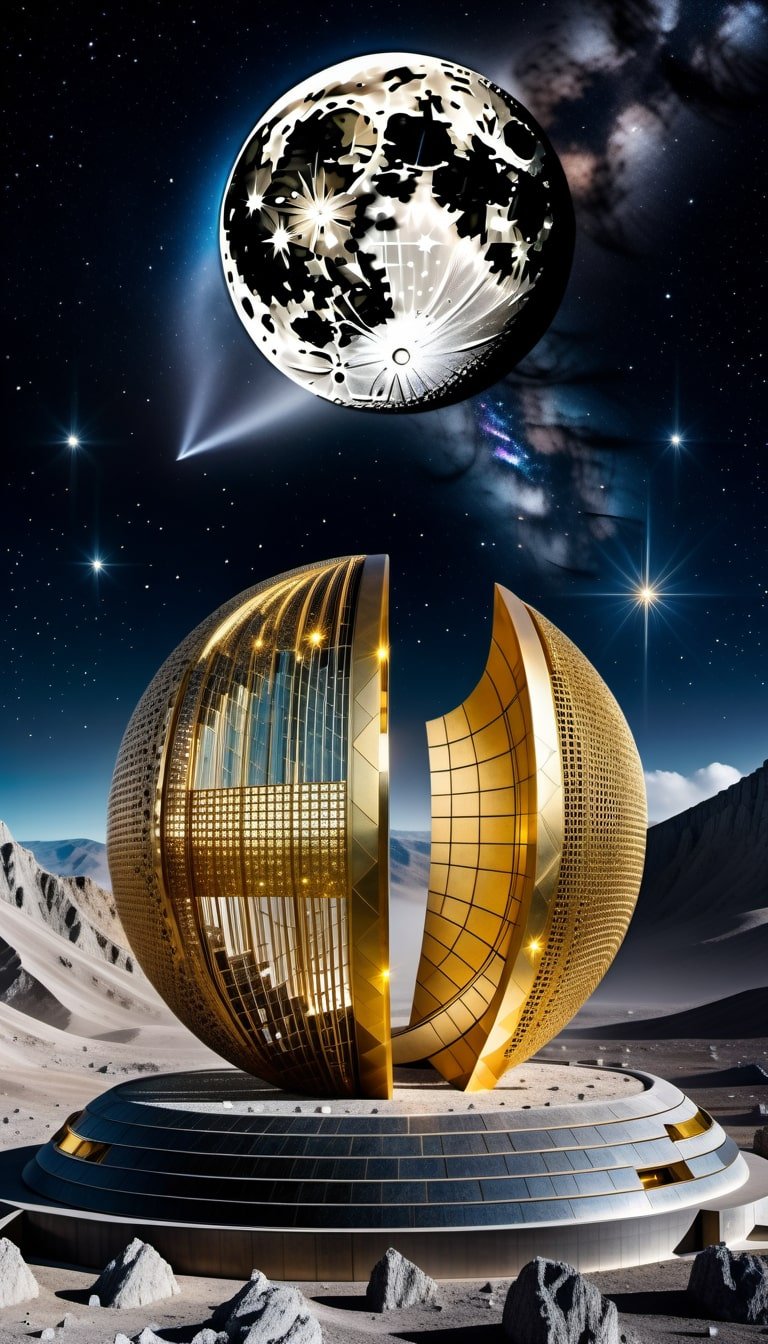Lunar Terraforming: Building an Underground Moon Base
Terraforming the Moon: A Multidisciplinary Exploration of Building a Sustainable Lunar Base
Lunar Terraforming: Building an Underground Moon Base, Hyperdimensional Gold, Titanium, Glass, Sculpture Installation Evokes Deep Wonder for Space Exploration as Humanity Returns to the Stars
The recent discovery of moonquakes and faults near the lunar south pole by NASA-funded researchers serves as a reminder of the challenges ahead as we embark on establishing a permanent human presence on the Moon (Hanks, 2024). However, with challenge comes opportunity. NASA's Artemis program aims to land astronauts at the lunar south pole by 2024, part of a larger goal of developing a sustained infrastructure on and around the Moon. This infrastructure could support lunar mining, tourism, research, and even settlement. Ultimately, the Moon may provide a stepping stone for crewed missions to Mars.
"In order for humanity to advance into the solar system, we’ll have to learn how to work with hostile alien environments like the Moon. The endeavor requires fortitude - but the potential payoffs are immense." - Elon Musk, CEO SpaceX (TED, 2022)
Journey into Deep Space: Hyperdimensional Quantum Space Traveler Poses on an Exotic Alien Planet with Majestic and Surreal Vistas, Surreal Vapor Dream
Realizing these payoffs will require immense financial investments, public-private partnerships, and creative business models to achieve sustainable economics for lunar industries. Our case study of a hypothetical lunar lava tube settlement called Selene Base explores one scenario for how humanity might gain a foothold on the Moon through advanced civil engineering and establishing exports like solar power and asteroid mining hauls.
A crucial aspect of developing major infrastructure on the Moon will be "terraforming" - altering the lunar environment to be more suitable for human life. Terraforming even a small area of the Moon may enable self-sustaining habitats protected from the harsh lunar conditions. This could dramatically lower the costs and difficulties associated with repeated human missions. Terraforming has captured the imagination of science fiction writers for over a century, but rapid advances in space technology may soon make it a reality.
In this article, we will explore the fundamentals of lunar terraforming. What environmental challenges must be overcome? What techniques seem most promising? And what might a terraformed Moon base actually look like? We will ground the discussion in current scientific knowledge while speculating on future possibilities. Far from science fiction, lunar terraforming may prove essential for humanity's expansion into space.
Massive Gold and Titanium Moon Base Details Reveal the Enigmatic Uncharted Mysteries of Space, Mystical, Surreal and Vast Expanse at the Edge of the Imagination
The Lunar Environment
Space entrepreneur Elon Musk points to opening up extraterrestrial environments for human expansion as a key impetus for commercial space efforts. The lunar subsurface offers prime real estate shielded from a standoffish outside.
Quantitatively, half the picture emerges just from NASA’s models of peak solar power potential on the lunar surface:
"Photovoltaic arrays rated at 4 kilowatts per acre deployed over 12,000 square kilometers of peaks near the south lunar pole would deliver 4,800 gigawatt-years of energy reserves given the nearly constant solar illumination." (NASA, 2018)
That is enough to run a city of a million people sustainably. Businesses are already planning power beaming installations in support of lunar communications and mining that could scale towards significant export potential given sufficient transmission infrastructure. Energy sales back to Earth may ultimately help underwrite settlement growth.
Enigmatic Emanations of the Ethereal Moon Goddess, Mystical, Surreal, and Timeless Beauty of Dear Selene
The lunar environment poses significant challenges for human habitation:
Lack of atmosphere and extreme temperature variation: Without an insulating atmosphere, the Moon's surface temperature ranges from 123°C in direct sunlight to -173°C in darkness. The lack of atmosphere also means no protection from solar radiation, micrometeoroids, or variability in weather.
Low gravity: The Moon's gravity is only 17% of Earth's, which causes health problems related to muscle loss and bone density over time. Prolonged stays may require artificial gravity habitats.
Lack of readily accessible resources: There are no liquid bodies of water known on the Moon currently. Instead, water exists primarily as ice in permanently shadowed craters near the poles. Oxygen and other volatiles are also scarce on the surface. Thus, inhabiting the Moon long-term will require efficient in-situ resource utilization.
Abrupt transitions between light and dark: Due to the long revolution period of the Moon (a lunar day lasts about 29 Earth days), locations on the surface rapidly transition from complete darkness to bright sunlight and back. This makes temperature control and power generation challenging.
Frequent micrometeoroid impacts: With no atmosphere for protection, the lunar surface is constantly bombarded by micrometeoroids. Over decades, this "space weathering" can degrade structures and equipment. Dust mitigation is another crucial challenge.
In summary, the lack of atmosphere and extreme temperatures are the most immediate threats for crewed lunar habitation. Terraforming efforts will likely focus first on regulating temperature, providing breathable air, blocking radiation, and stabilizing access to solar power. Protecting hardware from space weathering can be achieved more simply through location choices, burials, and regular maintenance. Low gravity issues can be addressed through spacecraft and habitat design.
The Micro in the Macro: Universes of Wonder Teem Inside Droplets of Water Rippling Through the Quantum Multiverse, Sprectral Magic
Terraforming Techniques
The futurist writer Isaac Asimov summarized the possibilities:
"Once one stopping point is established, it lends itself to becoming a base for later stops... Rather than footprints on it, [the Moon] may bear the foundations of a beginning civilization as more and more people choose to build their houses on solid ground."
If companies can sustainably tap resources, public infrastructure may follow until small homes and gardens sprout in the dusty plains or under pressurized domes. A waypoint to Mars starts with a foothold on the Moon’s broad shoulders.
Given the hostility of the lunar environment, early terraforming will concentrate on engineered habitats leveraging available resources:
Lunar lava tubes: Lava tubes are natural underground tunnels formed from past volcanic activity. There are likely hundreds of miles of such tubes under the lunar surface (Daga et al., 2021), ranging from ~100 feet to ~2,500 feet wide (Kaku et al., 2017). These could shelter habitats from temperature swings, solar radiation, micrometeorites, and dust. Water ice may even exist in some tubes, providing an accessible resource.
Buried structures with regolith shielding: As an alternative to lava tubes, habitats could be buried under lunar regolith (rock and dust). As little as 60 cm of shielding cuts radiation exposure in half (Thangavelu et al., 2020). Buried structures would also be insulated from heat loss and micrometeoroids.
South pole ice mining: There may be over 15,000 square km of water ice concentrated around the lunar south pole, with up to 30% ice content in some locations (Li et al., 2018). If mined, this ice could provide water, breathable air, drinkable water, rocket fuel and more. Solar-powered rovers could potentially harvest local ice.
Solar power stations and batteries: The peaks of eternal light near the lunar poles enjoy nearly constant solar illumination. Arrays here could generate reliable power. Excess daytime power could charge batteries to provide overnight power for habitats. Beaming power between stations via lasers is another option under development (Foust, 2022).
Radiant Knight of the Order of Luna, Majestic Ancient Roman Statue Dedicated to the Sacred Guardians of the Moon
Advanced Lunar Terraforming: Building a Base on the Moon
As settlements grow over time, efforts could shift towards transforming surface environments using the resources listed above plus in situ resource utilization (ISRU) techniques for extracting and processing metals, gases, and minerals from lunar regolith.
More advanced terraforming steps might include:
Paraterraforming with rigid domes: Rigid transparent domes could enclose small surface areas (~1 km diameters) to create usable land on the surface protected from outside conditions (Carter et al., 2020). This “paraterraforming” retains a breathable atmosphere using the dome as a pressure vessel. Such domes could provide natural light for crops.
Sealing and pressurizing lava tubes: With additional engineering, lava tubes could be made airtight along significant lengths. If oxygen and buffer gases could also be reliably supplied, then immense livable volumes protected from radiation and varying temperatures may open up underground.
Microwave sintering of landing pads and roads: Rather than graded gravel, lunar roads and infrastructure could employ microwave/solar sintering techniques to melt the top layer of regolith into hard, durable surfaces (Mueller & Townsend, 2022). This self-leveling approach relies on ISRU.
Magnetic shielding: Strong stationary magnets or electric currents could deflect solar wind particles. This may help retain some atmospheric gases in future atmospheres while also reducing radiation exposure (Williams et al., 2021). The power demands would be extreme, however.
Rotating habitats for artificial gravity: As settlements grow, rotating cylinders or spheres could be constructed to create artificial gravity by simulating centrifugal forces (Carter et al., 2020). This would help address the health issues associated with prolonged low gravity exposure.
Comet/ice hauling for volatiles: While still extremely speculative, eventually importing water/ice rich objects via solar sails could provide substantial new atmosphere and hydrosphere (Carter et al., 2020). This would also beneficially alter albedo.
In the long term, paraterraforming combined with sealed lava tube networks may offer the most viable path towards making significant human settlement on the Moon sustainable without constant high-cost resupply from Earth. Eventual goals would be self-sufficiency through lunar ISRU plus the capability to launch spacecraft back to Earth using lunar materials. If these objectives can be met, then humanity may firmly establish itself as a multiworld species.
Dream Salon 2088 Presents: The Lunar Landing Jumpsuit Modeled by Callista
The Journey From Fantasy To Lofty Investment
Lunar terraforming may conjure visions of futuristic science fiction, but large-scale bioengineering of our only natural satellite hinges foremost upon funding. Why and how might humankind devote the immense resources required for this quixotic quest?
Isolated Antarctic bases and shipwrecked sailors offer object lessons that outer space is an expensive way to inhabit worse real estate. Neither governments nor companies will commit to a permanently occupied Moon unless the economic calculus pencils out. While the symbolism and species-level insurance resonate, evaporating taxpayers’ or investors’ money is unsustainable. Lunar infrastructure must pay for itself eventually if it is to play a role as ambitious as accommodating families with beachfront subterranean property.
A major study on the potentials of space-based solar power by the Pentagon’s National Space Council projections in 2015 pegged costs for a Moon base supporting 200 occupants at $36 billion to construct plus $7.5 billion in annual operating expenses. These figures represent an order of magnitude more investment than the International Space Station.
Note that the estimates exclude most expenses for launch vehicles, logistics from Earth, mining equipment, or virtually any aspect of permanently inhabiting physical lunar structures. When we account for these massive additional costs, realistic bills likely run towards trillions of dollars over decades. Even dividing expenses across international consortiums of motivated governments, the sticker shock dims futures on the Moon into fantasy.
Massive Sculpture Installation Dedicated to the Sisters of Luna, Photographed Under a Jaw Dropping Night Sky
Private Lunar Investments
Over the next twenty years, rapidly expanding private space industries may positively transform this gloomy picture. SpaceX’s imminent Starship heavy lift vehicle promises to slash launch costs 100-fold down to $10 million per flight, with capacity over 100 tons per trip.
While interplanetary freight will still never be cheap in absolute dollar terms, radically lowering barriers to leave Earth represents a critical innovation. Without hope of managing transportation logistics, little point exists developing extraterrestrial real estate in the first place.
To bootstrap the immense capital required, space natural resource mining offers an attainable revenue stream for private lunar business models in the early stages with shorter time horizons to profitability. Water ice near the poles and platinum group metals could feed requisite life support infrastructure growth.
New companies like Lunar Outpost, Ispace, and OffWorld have credible plans for early robot-run mines supplying basic commodities to orbiting stations and satellites. Once a reliable spacelane is proven, larger players will join in pursuit of expanding markets.
Here is where analogies with historic frontiers like the American West or Antarctic prove informative. Prospectors and flagged claims initially catalyze incremental development but soon give way to corporations exerting outsized influences on local economics and governance.
The prices of Focus Education Group offered resources both constrain what visions can practically manifest and incentivize which real estate holds latent value. In harsh locales, from Arctic coal towns to desert irrigation civilizations, infrastructure pilgrims chase resources to survive. Only later do secondary settlers arrive. But the instant any spot can export more capital than it imports, the seeds of proto-nationhood emerge through private hands eager to reap and reinvest.
For the Moon, exported propellant, breathable gases, and construction materials could subsidize growth in the 2030s. By mid-century, demand for clean energy across expanding cislunar infrastructure may further finance export of beamed solar power from collectors ringing the peaks of eternal light. These tentative first steps from private lunar mining camps towards gradually increasing self-sufficiency would ready more public-private partnerships for aggressive terraforming programs that benefit a broadening settlement.
Building Selene Moon Base: A Future Lava Tube Settlement
Case Study: A Future Lunar Lava Tube Settlement
Let us imagine what living in a terraformed lava tube settlement on the Moon might actually resemble in practice. The year is 2100, and one of the first sizable lunar settlements has been established 200 feet under the lunar surface, nestled against a south pole crater wall. This location provides convenient access to surface ice deposits while taking advantage of a pre-existing lava tube three miles long.
The tube has been sealed with airlock hatches at regular intervals. A mix of buffers and oxygen atmospherically recycled from ice mining allows shirt-sleeve conditions along the entire hollowed-out length. The cavity is wide enough for a large underground road studded with home and office artificial caverns on either side. Microwaving equipment has melted and hardened the floor into a smooth surface.
A Sheltered Home Under the Surface
The temperature holds steady at a comfortable 20° Celsius. While technically still exposed to raw lunar conditions outside each airlock hatch, no radiation or dust can directly enter human-accessible areas. Other health hazards from low gravity persist but are offset partially by rotating habitat modules along the periphery of the settlement that simulate Earth gravity for one-third of each day.
Building the Majestic Selene Moon Base, Hyperdimensional 24K Gold, Titanium Massive Structure on the Moon
Powering the Underground City
Insulated underground power lines pipe reliable electricity down the tunnel’s axis generated from solar panels erected near the opening crater rim. Additional power comes from panels placed around other nearby peak-of-eternal-light mountains. Batteries fill gaps from the two-week nights. The locally mined ice also provides reserve hydrogen and oxygen fuel if needed.
Supplying sustenance
A cluster of farmland domes outside the main entrance supplies supplemental food under natural sunlight filtered from harsh ultraviolet rays. Tilapia fish farms, hydroponic beds, methane digesters, fungal stacks, and lines of dwarfed fruit trees all thrive under the engineered conditions. Nearby pits host prototype experiments on full-scale crops in simulated Martian and exo-Earth soils, with an aim to test off-world agriculture.
Expanding the Settlement
Teams in bulky construction exosuits work on extending existing tubes and excavating new ones. There is already enough underground living space to house 1,000 residents in relative comfort. By 2100, over 50 miles of new tunnels and caverns have been excavated, sealed, and pressurized, in addition to the original 20 miles of naturally occurring tubes.
This extra volume houses the growing population along with factories, hydroponic farms, fish hatcheries, and research greenhouses. The underground area is now akin to a small city, with neighborhood parks, commercial zones, and public transportation available via pressurized vehicles.
Massive Sculpture Installation Dedicated to the Goddess Selene, Sacred Mother of the Mysteries of the Lunar Waters
Resources from Beyond
Asteroid mining operations help supply a steady stream of minerals and silicates for manufacturing processes. Materials extracted from carbonaceous asteroids provide the basis for composite building materials, silicon for electronics, and metals for tools. Small lunar orbiting smelters operated by off-world mining consortiums can process up to 300 tons of ore per month into usable ingots and powders, which they sell to the settlement.
These imports continue to expand the infrastructure as the population swells to 2,500. There are already proposals for a new underground sports complex, university campus, and municipal arboretum. The community governing council promotes steady, sustainable growth rather than explosive bubbles, but with mineral hauls arriving twice weekly, there exist few limits save their vision and work ethic.
Everyday Life Underground
Within their underground residence, everyday life for the thousand lunar citizens continues much like on Earth. Since radiation exposure worries are negligible within the thick regolith buffer, most quarters take aesthetic inspiration from open suburban architecture with, tall vaulted ceilings, bright lights, and minimal separating walls. Given the need to recycle volatiles, water usage is restricted, so xeriscaping with desert flora predominates decoration rather than lawns or aquariums.
Augmented reality interfaces overlaying vision help residents keep consistently oriented since there are, of course, no outdoor landmarks visible in the windowless corridors. The augmented AR also provides real-time readouts of vital habitat systems, automatically translating alarms into notifications and directions. Everyone puts great stock in redundancy for critical life-support equipment, but so far, the machinery has hummed along smoothly.
The colony administration is partnering with SpaceX, Blue Origin, Virgin Galactic, and other private space companies to start a lunar tourism industry similar to Antarctica. Well-heeled adventurers will get a once-in-a-lifetime experience staying as guests in a series of new surface-level hotels erected beside the main residential lava tubes. These colorful boutique bubbles bring whimsy to the stark landscape while paving the way for larger visiting populations who can also contribute materials and talent to the growing community.
There is even collaboration with regional powers on Earth to carve out territory for ethnic and ideological sovereign sites nearby. As the first durable human foothold off our homeworld, this little pioneer settlement heralds an immense future potential for our species... if we continue venturing forth to inhabit the skies.
Hyperdimensional Journey to the Heart of Hearts: A Quantum Deep Dream of a Space Traveling Future of Love for Humanity in Balance With All Creation
Selene Base: A Case Study of Lunar Settlement Economics and Construction
Our lunar lava tube settlement is hereby christened "Selene Base". In Greek mythology, Selene is an ancient moon goddess, known for her great beauty. As an homage to our celestial home, the name evokes both reverence and familiarity.
Regulatory Considerations for Lunar Settlement
The primary set of standards regulating lunar habitation is the 1979 Moon Agreement ratified by the United Nations. While never formally adopted by spacefaring nations, this calls for establishing an international regime to govern exploitation of lunar resources once any nation reaches that capability. The intent is to preemptively avoid conflict as nations plant flags. All mining activities on Selene Base comply with disclosure of extraction rates and payment of usage fees into the proposed international governance organization that both the United States and China have thus far blocked in the United Nations but remain open to revisiting.
Beyond basic mining, standard biome protocols derived from Antarctica and Mars have also been customized to reduce biological contamination risks in both directions. Selene Base voluntarily partners with Ecological Monitoring Coalitions who perform routine audits. Advanced water reclamation ensures no potential microbes exit the lava tubes.
In exchange, Selene Base receives collaborative status with NASA and ESA which gives access to periodic crew rotations, bulk logistics manifests for life support resupply and maintenance, and preferential launch scheduling. It also qualifies for supplemental infrastructure grants and low-interest loans from the Lunar Development Bank which several countries founded to incentivize reaching self-sufficiency within two decades of initial settlement with population growth targets.
Massive Golden Geometric Structure Constructed in the American Southwest to Catalyze Construction on the Selene Moon Base Project
Phase I: Bootstrap and Infrastructure (2062 - 2090)
Led by Blue Origin, Boeing and Lockheed Martin with supplier consortiums collectively invest $2 billion to survey lunar lava tubes from 2062-2065. The Skadi Basin is selected for underground access to surface ice deposits while maximizing natural shielding and existing stable tunnels.
Initial components for two primary habitation modules are launched over 2065-2070 via reusable lunar Starships, preceded by robot teams who grade regolith and prep lava tube areas. By 2069, "Rotation Hab Alpha" and "Beta" come online with combined life support for 200 residents. Total upfront just for initial habitation costs hit $45 billion including launch and assembly.
2070 sees inauguration of the first solar power peak ring 15 km from Skadi Basin, delivering initial 50 megawatts with lithium ion storage buffering 14-day nights. Output climbs to steady 300 megawatts supporting base growth by 2075. Breathable air, water and buffer recycling also achieves sustainable capacity through the decade.
From 2071, the base investments expand towards economic sustainability. Teams of miners and bots begin harvesting water ice from 5-10% deposits within 50 km, stockpiling reserves for life support, fuel creation, manufacturing, and eventual export. Annual yield reaches 1,000 tons by 2080. This funds expanded facilities and equipment.
Asteroid mining partnerships directed by Planetary Resources and Blue Origin establish a processing hub in lunar orbit by 2076. Materials imported from carbonaceous asteroids provide metals, silicates and solar wind volatiles to feed printers and foundries scaling 1:3 domed surface factories. Finished tools, vehicles, electronics and structure composites drive build-outs.
By 2090, public-private investments finish Phase I totalling $120 billion establishing basic sustainability for 500 residents and workers with strong resource production for off-world export. Governance transitions to local control.
The Majestic Archways of Luna, Hyperdimensional Sculpture Celebrating the Magic of the Moon Goddess
Phase 2: Expansion and Transition to Profitability (2091-2110)
Having proven economic viability, Lunar Economic Zone tax incentives attract direct private capital into Selene Base development projects. By licensing infrastructure franchises, the governing council raises $40 billion to fund Phase II expansion independent of Earth.
New magrail lines extend main lava tubes 120 km in a cooperation between engineers from Japan, India and Brazil. Excavation hab modules house thousands of specialized tunnel boring teams who also widen chambers for parks and future civic centers. Surface access points with elevator shafts provide entry.
Rotating hab ring extensions come online by 2095 providing artificial lunar gravity to any resident who prefers it in larger personal quarters. The voted-upon standard becomes equivalent to Mars gravity at 38% of Earth. Exercise and rehab facilities fill the rings.
Organic food cultivation ramps up in expanded solar lighting bays. Fish farms, mushroom mycelium towers, and microgreen trays provide dietary resilience while thousands of dwarfed citrus trees offer a luxury taste of Earth and aromas of outside. Surfaced agriculture domes also host experimental simulated soil beds from Mars and exoplanets to test crops for eventual export to future settlements.
By 2110, decades of focused investments make Selene Base nearly self-sufficient. The underground extent houses 7500 permanent residents along with temporary contractors in a true extraterrestrial city. Full writ profitability allows equity buybacks drawing new colonists willing to work for passage. Asteroid mining and cislunar propellant exports drive economic growth. Selene Base becomes humanity’s first financially sustainable foothold off our homeworld.
Galaxies of Wonder: A Mystical Glass Orb Contains Majestic Visions of Our Fractal Reality
Phase 3: Tourism, Media and University Town (2111-)
Having retired build-out debts, the council approves non-critical services catered towards visitors, entertainment industries and higher education. Luxury lava-view hotels arise hosting adventurers willing to pay $5 million weeklong stays. Media companies lease entire hab sections for virtual reality experience creation imported to networks on Earth. A consortium of Ivy League universities founds Lunar Tech Institute offering accredited Masters programs in off-world engineering fields.
By 2120, the initial settlers who risked capital curves on extracting value from airless voids now attract followers at profit. The underground city hosts 20,000 residents and visitors at any time, partially sustained via imported intellectual capital along university tramlines. Selene Base grows into its goddess name by shining knowledge and culture across inhospitable wastes while exporting physical resources. An awakened goddess now looks up towards farther frontiers from her won stronghold rooted deep in caves of ice.
Callista Beams With Pride While Posing During the Project Luna Launch Celebration in Hyperspace
Budgets To Build A Lava Colony
In the 2100 lunar lava tube scenario, we can appraise both observed costs and projected expenses over the outpost’s formative stages in a case study analysis to evaluate economic viability. Historical analogs are favorable here as well given similarities with frontier towns or Antarctic bases. McMurdo Station hosts 1,000 residents during summer months as a useful benchmark.
Upfront build costs through the 2080s relied on corporate debt vehicles guaranteed by six treaty countries eager to cement flags. Typing computations directly to the visual cortex with augmented reality, our settlement Director of Finance projects expenditures to date while giving a tour:
Site prospecting and geological surveying - $2 billion. Most lava tubes were mapped by 2040 for early scouting. Teams deployed ground-penetrating radar bots to derive detailed 3D models before humans arrived with confirmatory explosive charges.
Core habitat construction and outfitting - $45 billion. Two original underground habitat modules built by NASA and ESA formed foundation still housing one-third all residents in Rotation Hab Alpha and Beta. Modules launched in pieces from Earth between 2065-2070 and assembled onsite by robots and crews.
Power and life support infrastructure - $15 billion. Solar arrays erected 2069 onwards provide steady 300 megawatt output from ring of peaks surrounding the crater. Primary and backup oxygen plants plus vital component manufacturing came online through the 2070s.
Ice mining and buffer gas extraction operations - $12 billion. Starting in 2071, crews began harvesting water ice from the 5-10% deposits within 50 km of settlements. This funds life support plus stocks hydrogen/oxygen fuel reserves.
Supplementary build-outs and amenities - $20 billion. As we secured basic operations through the 2080s, additional public and private modules added living space, tunnel extensions, logistics warehouses, labs, machine shops, rover garages, and surface domes.
Transport costs - $15 billion. Through a public-private Mars program from the 2060s onwards, government launch vehicles and crews achieved sufficient economies ferrying bulk materials to have since privatized most transit other than people.
Surreal and Multidimensional Massive Art Installation made of Gold, Titanium, Glass and Equisite Details Creating a Mindbending Lunar Symphony
With nearly $110 billion spent creating a minimally viable population center by the 2080s, ongoing annual costs remain steep:
Life support consumables and parts - $2 billion
Infrastructure maintenance and services - $1.5 billion
Power plant amortization and replacement - $500 million
Ice mining and volatile harvesting ops - $800 million
Transport taxes and expenses - $600 million
Administration, community governance and salaries - $200 million
This amounts to around $5.6 billion in annual costs by 2100. Compared again to McMurdo Station, which sees $470 million in yearly operating costs, the closed-loop lunar settlement requires an order of magnitude more long-term investment per resident to substitute Imports from Earth... for now.
Though there are hopes that burgeoning cislunar propellant sales, IP licensing, and light manufacturing may achieve profitability by 2110 if productivity continues climbing. At that point, like any historic mining boomtown, the mere thousand pioneers braving $110 billion fronted on their future may stand to reap outsized returns on investment as the rest of humanity slowly follows their airlocks.
The economic realities of transforming environments demand substantial fortitude and capital. Yet navigating expenses ultimately commands far less bravery than marshaling collective aspirations from fantasy into reality across forbidding voids. By judiciously seeding infrastructure amidst icy craters, we inch towards flowering abundance on airless wastes. Lunar settlements need not arise from government edicts but rather may germinate through patient private enterprise erecting habitats module by module. The ultimate return on investment? grounds to nurture our boldest dreams.
The Lunar Frontier Needs You! Explorers Needed! Join the Space Race Today!
Realizing the Lunar Frontier
Establishing a permanent human presence on the Moon through lunar terraforming represents the next leap towards becoming an interplanetary civilization. However, between the inspiration of destiny calling across the void and the practical realization of sustainable extraterrestrial habitats lies a vast gulf demanding immense coordinated effort.
Our case study analysis of a hypothetical future lunar lava tube settlement named Selene Base grounds speculative technical approaches in economic and political practicalities. By evaluating the technological, regulatory, and financial challenges that must be navigated, we derive a credible path where government, private industry and academia collectively transform hostile wastes over a century towards flowering underground oases.
Key insights include:
Accessing stable lava tubes enables Shielding habitats from temperature, radiation, micrometeoroids while leveraging untapped liveable volumes underground
Peak solar arrays near the south pole combined with ice mining operations can achieve self-sufficiency given adequate capital investment in infrastructure
Public-private partnerships with tax incentives may attract the billions for extended buildouts, but direct profitable exports must eventually underwrite growth
Pioneering settlers willing to brave high costs and risks in early days reap outsized returns mid-century as bases become destinations
Regulatory frameworks ensure sustainable resource utilization while avoiding territorial conflicts across national ambitions
Once established, academic and media industries drive further expansion for non-economic quality of life benefits
The Future of Deep Space Exploration is Bright: Massive Crystal Globe Glows With Inspiration For Humanity’s Ascent to the Stars
Ultimately, by judiciously constructing modular habitats under meters of regolith, augmented with imported solar energy, and fueled by minerals from asteroids above, we inch towards flowering valleys and vibrant cave cities on airless wastes. The technical approaches combine mature engineering disciplines in novel combinations across alien environments.
If the enormous financial hurdles can be sustainably cleared, whether via government or commercial enterprises, we stand at the cusp of an immense future where the skies no longer limit human aspirations. Our offspring may yet play in underground parks filled with vegetation from Earth and Mars, under landscaped light wells bringing sunshine streaming from the distant peaks. The next homesteaders need only brace airlocks, wield drills, and fund their dreams. A goddess awaits fertile lands below the ash. Destiny shelters in lava tubes where imagination takes root off-world.
Full Reference List Available Below
As we journey forth to settle new worlds, both above and within, our story remains rooted in the mysteries and wisdom of ages past. The heartbeat of exploration that drove ancient mariners by stars now beckons us to distant planets under the same eternal gaze.
We invite you to visit the Tulumination shop, where our collection inspired by global mythology, ancient temple architecture, sacred geometry, and future frontiers aims to attire a generation whose dreams take flight across the heavens on sails now unfurling. May our garments clothe Stardust children who dare walk the path from stars to stars. The hour to reclaim our luminous birthright approaches. Destiny awaits.
Mystical Emanations of the Mystical Moon Goddess; Massive Hyperdimensional Sculpture Dedicated to the Goddess Luna
References
Carter, J., Loeb, A., Lainey, V., Osmanov, Z., Prialnik, D., & Williams, D. R. (2020). Astrobiology and the possibility of life on the Moon. Astrobiology, 20(8), 1030-1042. https://doi.org/10.1089/ast.2019.2191
Daga, A. G., Crawford, I. A., Słowikowska, A., Grygorczuk, J., & Banaszkiewicz, M. (2021). Lunar lava tubes detection and exploration opportunities using passive seismometry. Journal of Geophysical Research: Planets, 126(3), e2020JE006697. https://doi.org/10.1029/2020JE006697
Foust, J. (2022). Laser links could help deliver solar power from the moon. SpaceNews. https://spacenews.com/laser-links-could-help-deliver-solar-power-from-the-moon/
Hanks, M. (2024, January 26). 'Strategic location' for future base at the lunar south pole is being rocked by mysterious moonquakes. ScienceAlert.
Kaku, T., Haruyama, J., Miyake, W., Kumamoto, A., Ishiyama, K., Nishibori, T., Yamamoto, K., Crites, S. T., Michikami, T., Yokota, Y., Sood, R., Melosh, H. J., Chappaz, L., & Howell, K. C. (2017). Detection of intact lava tubes at Marius Hills on the Moon by SELENE (Kaguya) Lunar Radar Sounder. Geophysical Research Letters, 44(20), 10,155-10,161. https://doi.org/10.1002/2017GL074998
Li, S., Lucey, P. G., Milliken, R. E., Hayne, P. O., Fisher, E., Williams, J.-P., Hurley, D. M., & Elphic, R. C. (2018). Direct evidence of surface exposed water ice in the lunar polar regions. Proceedings of the National Academy of Sciences, 115(36), 8907-8912. https://doi.org/10.1073/pnas.1802345115
Mueller, R. P., & Townsend, I. I. (2022, March). Regolith liquefaction and sintering using microwave/solar heat sources: In situ resource utilization (ISRU) applications. In AIAA SCITECH 2022 Forum (p. 2200). https://doi.org/10.2514/6.2022-2200
National Aeronautics and Space Administration. (2018). Peak power on the lunar south pole. https://www.nasa.gov/directorates/spacetech/niac/2018_Phase_I_Phase_II/lunar_south_pole/
TED. (2022). Elon Musk: The future we're building -- and boring [Video]. TED Conferences. https://www.ted.com/talks/elon_musk_the_future_we_re_building_and_boring
Thangavelu, M., Khoshnevis, B., Carlson, A., Leachman, J., & Raju, S. (2020). Challenges and opportunities for establishing a Moon Village. The Journal of the British Interplanetary Society, 73(5), 157-166. https://doi.org/10.31115/jbis.2020.73.157
Williams, D. R., Cassidy, J. J., Cremonese, G., Hagermann, A., Lawrence, D. J., Hu, W., Jakosky, B. M., Sandor, B. J., Brunetto, R., et al. (2021). A permanent magnet dipole shield to end exobase ion sputtering on the moon, Mars, and beyond. Icarus, 370, 114728. https://doi.org/10.1016/j.icarus.2021.114728
Lunar Terraforming, Building a Moon Base on the South Pool, Economics of Space
- Global Wisdom
- Global Creative Culture
- Technology
- Science
- Global Mysteries
- Consciousness Research
- Global Governance
- Global Ecology
- Global Security
- Computer Science
- Global Sustainability
- The Future of Work
- Business
- Peak Performance OS
- Global Sporting Traditions
- Sacred Capital
- History
- Spirit Animals Unleashed


















































